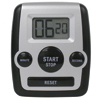Yeti Niner Five
Pre-takeoff checklist
Question for you instrument-rated types...what kind of timer do you use?
I'm about halfway through my instrument training and have decided I'd like a timer in the cockpit. The Arrow that I'm flying has a clock with a second hand, but I think I'd prefer a timer.
But I'd like to know what you guys are using and even how you use it. I'm sure everyone has their own way to do it.
I'm about halfway through my instrument training and have decided I'd like a timer in the cockpit. The Arrow that I'm flying has a clock with a second hand, but I think I'd prefer a timer.
But I'd like to know what you guys are using and even how you use it. I'm sure everyone has their own way to do it.





